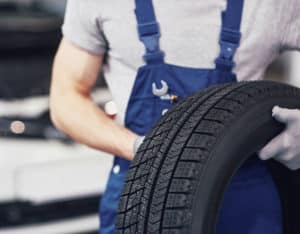Why Are My Tires Wearing Unevenly?
Tire tread patterns can tell you a lot about your vehicle if you know exactly what to look for. Checking your tires’ tread depth and wear condition is an easy way to know when it’s time to replace them. The overall condition can even serve as a warning sign that your vehicle needs a different type of general maintenance.
If you’ve found your tires wearing unevenly, this can either be a sign of improper inflation pressure, out-of-spec tire alignment, or a defective suspension part. We’ll go through the ways in which you can identify these issues in order to solve them as soon as possible.
Issue: Improper Inflation Pressure
 The right inflation pressure in your tires optimizes the distribution of the vehicle’s load, as well as acceleration, braking, and cornering forces in the tread. Every vehicle’s manual will state the specifications of proper inflation pressure. On most vehicles this information is on a white label attached to the driver’s door end or the center post that the driver’s door closes on.This should be checked regularly, as it also serves as a way to optimize performance for ride comfort, handling, and fuel economy.
The right inflation pressure in your tires optimizes the distribution of the vehicle’s load, as well as acceleration, braking, and cornering forces in the tread. Every vehicle’s manual will state the specifications of proper inflation pressure. On most vehicles this information is on a white label attached to the driver’s door end or the center post that the driver’s door closes on.This should be checked regularly, as it also serves as a way to optimize performance for ride comfort, handling, and fuel economy.
Improper tire pressure means that the contact patch of the tire tread isn’t able to handle everything demanded of it, which results in uneven tire wear.
If your tires show greater center wear, it means they’re overinflated. Greater edge wear, on the other hand, indicates underinflation.
Be sure to check your tire pressure regularly and keep it within your vehicle’s specifications, especially before going on long trips or when carrying an especially heavy load.
Issue: Out-Of-Spec Tire Alignment
When we talk about tire alignment, we’re referring to the adjustment of the vehicle’s steering and suspension components. Each vehicle’s specifications will indicate the proper alignment parameters, such as camber, toe, and caster, which signify the correct angles of the tires necessary to ensure proper contact with the road and to prevent premature tire wear.
A sign that your vehicle needs a professional tire alignment is uneven tire wear in the form of heel/toe tire wear. This is when one side of the tread blocks wears faster than the other, making the tread blocks feel like saw teeth.
Another obvious sign would be feather edge tire wear in which tread ribs are worn lower/smoother on one side and higher/sharper on the other, or one-sided shoulder tire wear, in which the inside or outside shoulder rib of the tread is more worn than the other ribs.
Issue: Bad Suspension
Bad suspension can affect your ability to control your vehicle, particularly when stopping or turning. This can be a very serious problem. Uneven tire wear in the form of balding spots or diagonal scalloping on the tire, also known as cupping wear, is a clear sign that you’re dealing with a worn, bent, or compromised suspension and should immediately schedule an appointment with your mechanic for a professional inspection.
As you can see, tire patterns can be a great tool to determine the overall health of your vehicle. By keeping a close eye on your car’s uneven tire wear, you’ll be able to better spot the underlying problems and work alongside your trusted mechanic to solve them effectively.

Leave a Reply
You must be logged in to post a comment.